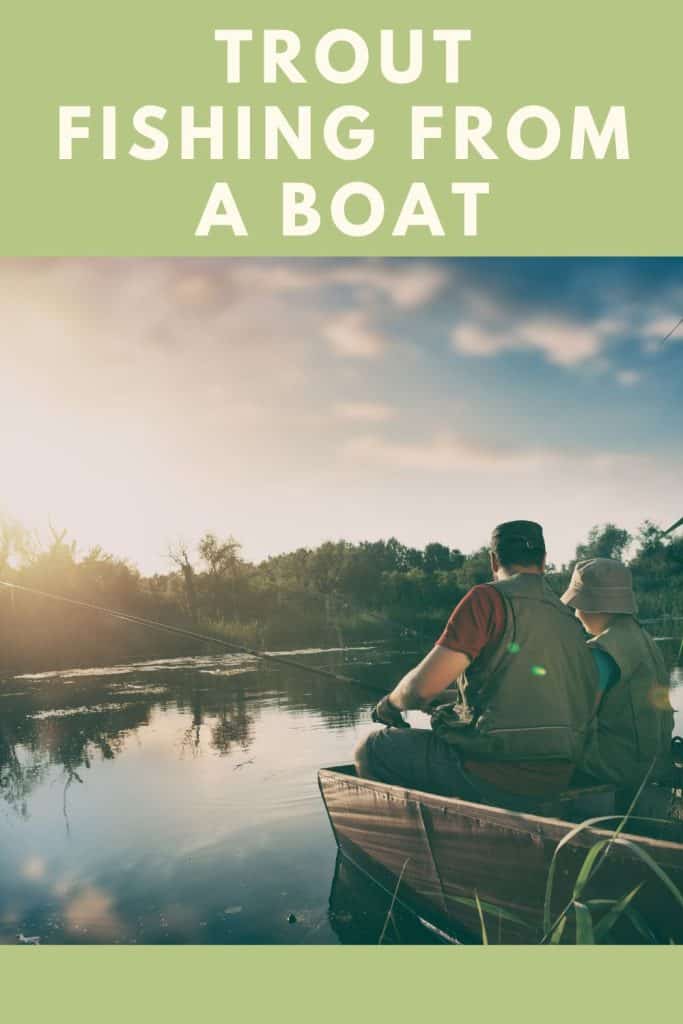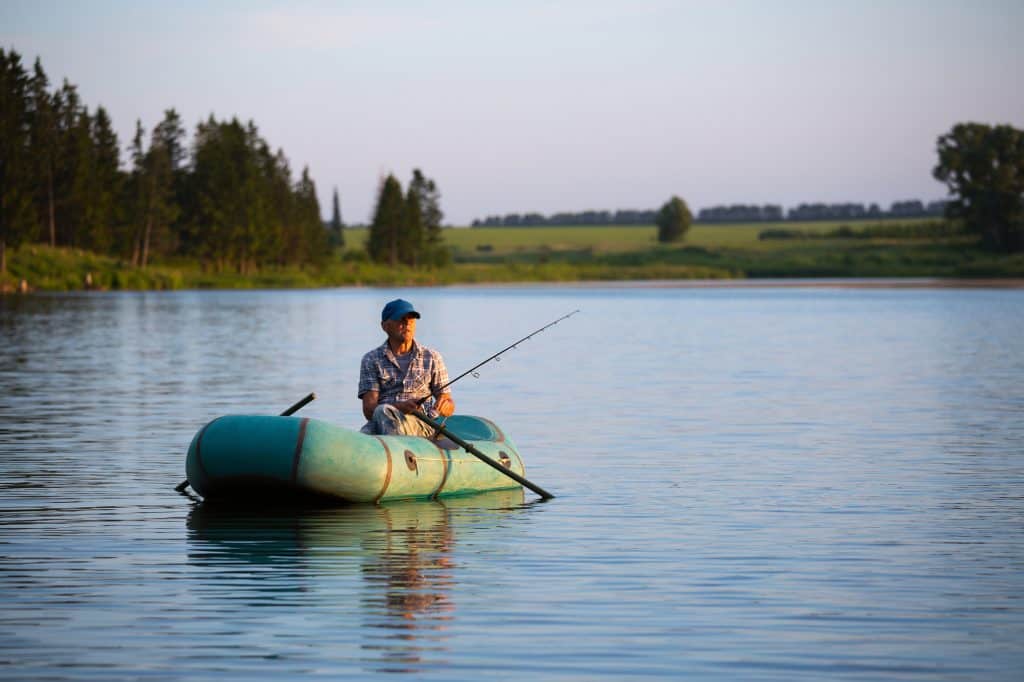Last Updated on October 2, 2023 by Kyle Whitley

Trout fishing from a boat is an exciting and rewarding experience for both novice and experienced anglers. Fishing from a boat opens up a world of possibilities, from exploring new lakes and rivers to accessing hard-to-reach areas where fish may be hiding. Boat fishing also allows anglers to cover more water and try different techniques, increasing their chances of catching a fish.
When it comes to trout fishing, being in the right location is crucial. Lakes and rivers are great places to start, but it’s important to research beforehand to find out which areas are known for good trout fishing.
Once the location is determined, it’s time to hit the water. Fishing from a boat provides an advantage over shore fishing, as anglers can move around and try different spots until they find where the fish are biting. Boats also allow anglers to fish in deeper waters where trout may be lurking.
When fishing from a boat, having the right equipment is important. A sturdy fishing rod and reel, a variety of lures and baits, and a good fish finder are all essential tools for successful trout fishing. Anglers should also be aware of local fishing regulations and obtain necessary licenses or permits before heading out on the water. With the right equipment and knowledge, trout fishing from a boat can be a fun and rewarding experience.

Contents
Benefits of Trout Fishing from a Boat
Trout fishing from a boat can offer several advantages over other fishing methods. Here are some of the benefits of trout fishing from a boat:
Access to Deeper Waters
One of the biggest advantages of fishing from a boat is accessing deeper waters. Trout often inhabit deeper waters, especially during the warmer months when the water temperature rises. By fishing from a boat, anglers can easily navigate to deeper waters and target trout that are not accessible from shore.
Ability to Cover More Water
Fishing from a boat allows anglers to cover more water than they can from shore. This means that they can explore more areas and locate more fish. Trout move around a lot, especially in rivers and streams. By fishing from a boat, anglers can follow the fish and increase their chances of catching them.
Better Chance of Catching Trout
Trout fishing from a boat can significantly increase an angler’s chances of catching fish. As mentioned earlier, fishing from a boat allows anglers to access deeper waters and cover more water. Additionally, boats are less likely to spook fish than anglers wading in the water. This means that anglers have a better chance of catching fish not scared away by their presence.
In addition to these benefits, boat fishing can be more comfortable and convenient. Anglers can bring more gear with them and have a place to store it while they fish. They can also take breaks and relax in the boat when needed.
When choosing a location for trout fishing from a boat, it is important to consider the type of water and the regulations in place. Some bodies of water may restrict the use of boats or specific areas where boats are not allowed. Researching the location beforehand and following all regulations is important to ensure a successful and legal fishing trip.

Essential Gear for Trout Fishing from a Boat
Boat and Motor
When trout fishing from a boat, having a reliable and sturdy vessel is essential. A small aluminum or fiberglass boat with 5 to 15 horsepower motor will suffice for most trout fishing expeditions. The boat should have safety gear, such as life jackets and fire extinguishers, and basic navigation equipment, such as a GPS and compass.
Rod and Reel
Selecting the right rod and reel is crucial for successful trout fishing. A lightweight spinning rod and reel combination with a 4 to 6-pound test monofilament line is ideal for most trout fishing situations. For those who prefer fly fishing, a 5wt fly rod and reel with a matching fly line is recommended. It is important to choose a rod and reel appropriate for the size of the fish being targeted.
Leader and Line
The leader and line are critical components of trout fishing tackle. A fluorocarbon leader with a length of 7 to 9 feet and a diameter of 4 to 6 pounds is suitable for most trout fishing situations. The main fishing line can be either monofilament or braided, weighing 4 to 6 pounds. It is important to match the leader and line to the size of the targeted fish.
Baits and Lures
Trout can be caught using a variety of baits and lures. Live bait, such as worms or salmon eggs, can effectively catch trout. Artificial lures, such as spinners, spoons, and jigs, can be successful. It is important to choose baits and lures that are appropriate for the type of water being fished and the behavior of the fish.
In summary, when trout fishing from a boat, it is important to have a reliable and sturdy vessel with basic navigation equipment and safety gear. The rod and reel should be lightweight and appropriate for the size of the fish being targeted, with a fluorocarbon leader and monofilament or braided line. Baits and lures should be chosen based on the type of water being fished and the behavior of the fish.
Techniques for Trout Fishing from a Boat
When it comes to trout fishing from a boat, several techniques can be effective. This section will cover trolling, vertical fishing, and trout rigs.
Trolling
Trolling is a popular technique for catching trout from a boat. It involves dragging bait or lures behind the boat at a slow speed. This allows you to cover a lot of water and increase your chances of catching fish.
When trolling for trout, it is important to use the right gear. A light to medium action rod and reel combo is ideal. You should also use a trolling motor or drift with the current to maintain a slow and steady speed.
Powerbait is a popular bait for trolling. It can be used with various rigs, including sliding sinkers or three-way rigs. When using Powerbait, choosing the right color and scent is important based on the fish’s conditions and preferences.
Vertical Fishing
Vertical fishing is another effective technique for catching trout from a boat. It involves dropping bait or lures straight below the boat and jigging them up and down.
When vertical fishing for trout, it is important to use the right rig. A simple hook, weight, and swivel rig is often effective. You can also use a jig or a spoon for added action.
Floats can also be used when vertical fishing for trout. They can help keep your bait at the right depth and provide a visual indicator when you get a bite.
Trout Rigs
A variety of trout rigs can be used when fishing from a boat. Some of the most popular include the Carolina rig, the drop shot rig, and the sliding sinker rig.
When choosing a trout rig, it is important to consider the fish’s conditions and preferences. You should also pay attention to the size and type of hook you use. In general, smaller hooks are better for trout fishing.
In conclusion, there are several effective techniques for trout fishing from a boat. Trolling, vertical fishing, and trout rigs are all popular options. Using the right gear and bait increases your chances of catching trout and having a successful day on the water.
Types of Trout to Target While Fishing from a Boat
Trout fishing from a boat can be an exciting and productive way to catch different types of trout. Anglers can target various trout species, including Rainbow, lake, and Steelhead. Each trout type has unique characteristics and requires specific techniques to catch.
Rainbow Trout
Rainbow trout are one of the most popular trout to catch while fishing from a boat. They are known for their bright, colorful appearance and their strong fight. Rainbow trout can be found in North America rivers, lakes, and streams.
When fishing for rainbow trout from a boat, anglers should use light tackle, such as a spinning rod with four to six-pound test line. Rainbow trout are often caught using artificial lures such as spinners, spoons, and jigs. Live bait, such as worms or minnows, can also be effective.
Lake Trout
Lake trout are a popular target for anglers fishing from a boat in deep, cold-water lakes. They are known for their large size and their delicious taste. Lake trout can be found in lakes across North America, including the Great Lakes region.
When fishing for lake trout from a boat, anglers should use heavy tackle, such as a baitcasting rod with 10 to 20-pound test line. Lake trout are often caught using downriggers or lead core line to troll deep water. Anglers can also use jigs or spoons to catch lake trout.
Steelhead
Steelhead are a type of rainbow trout that spend part of their life in the ocean before returning to freshwater to spawn. They are known for their incredible fighting ability and their acrobatic jumps. Steelhead can be found in rivers and streams along the West Coast of North America.
When fishing for steelhead from a boat, anglers should use a medium to heavy spinning rod with eight to ten-pound test line. Steelhead are often caught using artificial lures such as spoons or spinners. Fly fishing can also be effective for catching steelhead.
In conclusion, when fishing for trout from a boat, anglers should consider targeting rainbow trout, lake trout, and steelhead. Each type of trout requires specific techniques and equipment, but with the right approach, anglers can have a successful day on the water.
Summing it Up: Trout Fishing From A Boat
Fishing for trout from a boat can be an incredibly rewarding experience, but it requires patience, skill, and the right equipment. By following the tips and techniques outlined in this article, you can increase your chances of success and make the most of your time out on the water.
Whether you’re a seasoned angler or a beginner, there’s always something new to learn about fishing. So grab your gear, head out on the water, and enjoy the thrill of the catch!

